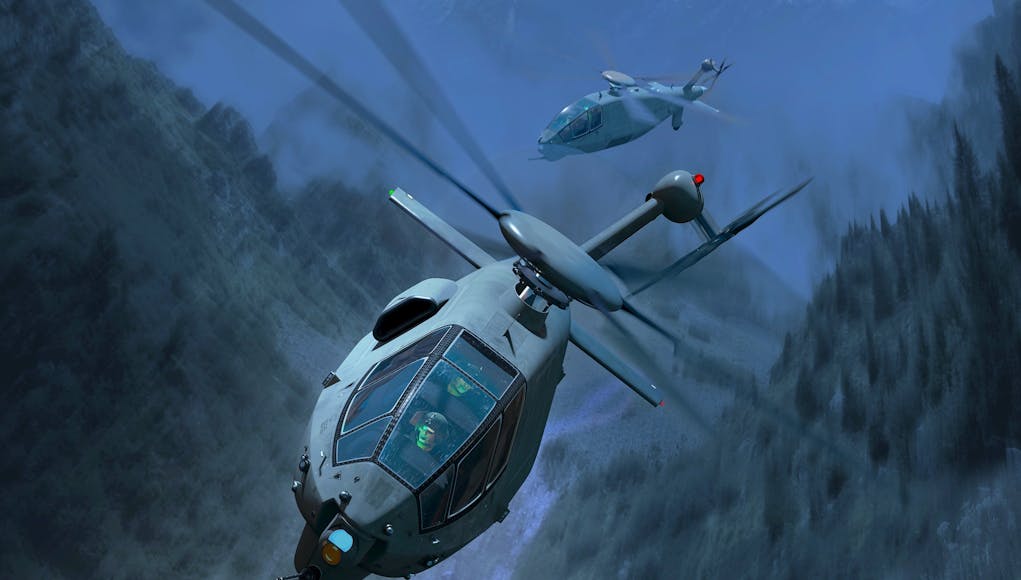Boeing is offering the U.S. Army a purpose-built aircraft for the Future Attack Reconnaissance Aircraft (FARA) prototype competition.
Boeing FARA is designed to meet the Army’s current mission needs while evolving as technologies and missions change, say the firm.
“The thrust compounded single-main rotor helicopter boasts a six-bladed rotor system, a single engine, tandem seating and a modular, state-of-the-art cockpit with a reconfigurable large area display and autonomous capabilities.”
“We’re offering more than a helicopter – we’re offering an affordable and fully integrated system for the Army, the mission and the future. We’ve blended innovation, ingenuity and proven rotorcraft experience with extensive testing and advanced analysis to offer a very compelling solution,” said Mark Cherry, vice president and general manager of Boeing’s Phantom Works.
“We listened to the Army, assessed all alternatives, and optimized our design to provide the right aircraft to meet the requirements,” said Shane Openshaw, Boeing FARA program manager.
“We are offering a very reliable, sustainable and flexible aircraft with a focus on safety and the future fight.”
FARA will fill a critical gap in US Army aviation for an advanced light attack and reconnaissance capability, previously held by the now-retired Bell OH-58D Kiowa Warrior.










Hmm, the above picture doesn’t show the full picture of the Boeing design. Check out the link to the Boeing publicity video:
https://www.youtube.com/watch?v=H8bXB3milTA
They have chosen an odd design. It combines a traditional helicopter main rotor and tail rotor, with a pusher propeller. The overall shape at least from the front follows the late Comanche project, complete with a pair of internal weapon bays. However, they have chosen to go with a tilted un-shrouded tail rotor to counter the main rotor’s torque reaction. By tilting the tail rotor much like the Blackhawks, it can generate some lift as well as providing thrust to counter the torque reaction of the main rotor. However, the tail rotor still uses 25 to 30% of the available engine power.
The addition of the propeller hints at a the possibility of a compound helicopter. This is where the drive and the collective angle of attack to the main rotor is reduced, so that it only provides lift and not thrust. Thus removing the load from the disc and also slowing the blades tips down. Thereby making sure the blades still provide lift as you go faster. In essence turning the aircraft into an autogyro. I doubt it will be a full autogyro as it will probably be the same as the Airbus X3, which reduces drive to the main rotor to something like 75 to 80%. The only issue being is that the Boeing design doesn’t use a supplementary wing to offset the lost lift, so the drive to main rotor may be as high as 90 to 95%,
The rear propeller provides all of the thrust once the aircraft goes past a critical speed. So perhaps the tail rotor is also clutched, where the drive is removed as it reaches a certain speed. Which is why I’m surprised they didn’t go with a fenestron tail rotor design. A case point is the Gazelle helicopter, when the aircraft goes above 55 knots the tail fin provides enough sideways force to counteract the main rotor’s torque reaction. So in essence the fenestron becomes redundant. But by enclosing it within the tail fin you significantly reduce the amount of drag that an unshrouded tail rotor would generate. It’s also a bit odd for a scout helicopter, which should be quiet. The traditional tail rotor design is noisy compared to the fenestron. For out and out speed the Airbus X3 design is the best at the moment. Unless anyone wants to reinvent the Rotordyne drive train for a scout/attack helicopter.